国际结算双语课程标准--英文版
国际结算全集合(英文版)

From cash settlement to non-cash settlement From goods trading to documents trading From direct payment between traders to payment effected through a financial intermediary
to maximize revenues; credit risks associated with financing extended to buyers or sellers
Factors in the payment decision
To exporters: protection against non-payment risks by the importers, such as: commercial risks, financial risks; political risks; risks in control of title to the goods,etc. convenience; cost; commercial competitiveness
Characteristics and developing trend
1. 2. the scale and scope of international settlement get greater and greater International lending and financing is closely combined with international payments On the basis of international customs and practice International guarantees applied to international settlement More diversified vehicle currencies The proportion of commercial credit in international settlement gets bigger A much facilitated international banking network connected with electronic telecommunication
国际结算(双语)教学全套课件1

Payment methods
Documents
remittances,
collPeactyimonesn,tlemtteetrhsods
of credit, standby lbeatnrcotkeoefmlrlgceiurotcaefttrdaiocanitnrnc,este,dessei,tltesa,,tntdebrys intleertntaetrioonfalcredit, facbtaonrkingguaanrdantees, forifnateitrinagtional
policies, certificates of origin, etc
Traditional payment method
case
• 1.The supplier agrees that the buyer will effect payments under the term of T/T against receipt of B/L by fax.
✓ UK Bills of Exchange Act of 1882; ✓《英国票据法》 ✓ US Uniform Commercial Code of 1962; ✓《美国统一商法》
• For documentary collections, documentary credits, standby credits, or guarantees, the applicable international customs and practices are:
factoring and forfaiting
commercial invoice,
pacDkoincgumlisetn,ts:
bilclsomofmleardciniagl, insinurvaoniccee,poplaiccikeisn,g celritsitf,icbailtlessooff orliagidni,nge,tcinsurance
《国际结算(双语)》-课程实验教学大纲

《国际结算(双语)》课程实验教学大纲一、课程基本信息课程代码:16081803课程名称:国际结算(双语)英文名称:International Settlements实验总学时:12学时适用专业:金融学、保险学、金融工程学、保险学课程类别:专业课先修课程:大学英语、金融学、商业银行经营管理二、实验教学的总体目的和要求(黑体/小四)1、对学生的要求:(1)专业教学要求:学生应掌握汇票的编制、汇票的贴现与背书相关业务、汇款电文编写与汇款申请书填写、托收项下汇票的编制、托收申请书填写、信用证申请书填写等国际结算实操业务。
所有内容的填写都用英文完成。
(2)思政教学要求:在实际国际结算业务操作中,学生应理解诚信重诺、坚守契约精神的信念,树立高度的职业责任心,认真完成实务操作中的每一步骤。
同时,培养学生分析问题与解决问题的能力,形成以发展眼光来看待问题的辩证思维。
2、对教师的要求:(1)专业教学要求:教师应在学生进行实操前,进行课程内容复习与方法指导,确保实验内容顺利进行;同时在实验过程中,学生遇到任何技术性问题,教师应予以及时解答;应对实验成果及时给分与评价,成绩计入实验课成绩。
(2)思政教学要求:教师首先应以身作则,提前准备好实验所需材料,并流畅解决实验当中遇到的问题。
同时,应在实验内容讲解过程中,通过潜移默化的方式向学生传递思政思想,并在实验考核中着重强调针对思政内容的评分。
3、对实验条件的要求:要求实验室应有电脑、投影以及网络,能够方便教师展示实验内容以及学生在电脑上完成实验操作。
三、实验教学内容实验项目一实验名称:汇票的缮制1(Negotiable Instruments)实验内容:各类汇票的制作、汇票的贴现、承兑通知书的填写实验性质:综合性实验学时:2学时实验目的与要求:(1)专业要求:要求学生掌握汇票中需要填写的项目类型,以及各项目填写的具体要求;掌握在不同类型远期汇票下,汇票到期日的计算方法;掌握汇票承兑通知书的填写方法;掌握汇票贴现期限、利息的计算方法。
国际结算英文版教学大纲
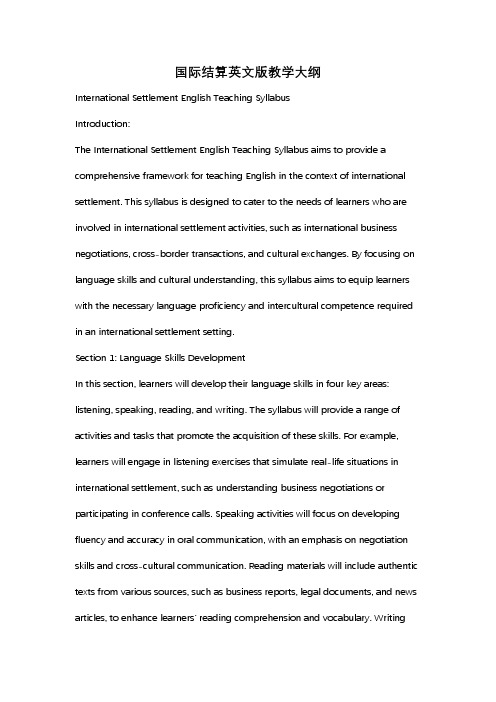
国际结算英文版教学大纲International Settlement English Teaching SyllabusIntroduction:The International Settlement English Teaching Syllabus aims to provide a comprehensive framework for teaching English in the context of international settlement. This syllabus is designed to cater to the needs of learners who are involved in international settlement activities, such as international business negotiations, cross-border transactions, and cultural exchanges. By focusing on language skills and cultural understanding, this syllabus aims to equip learners with the necessary language proficiency and intercultural competence required in an international settlement setting.Section 1: Language Skills DevelopmentIn this section, learners will develop their language skills in four key areas: listening, speaking, reading, and writing. The syllabus will provide a range of activities and tasks that promote the acquisition of these skills. For example, learners will engage in listening exercises that simulate real-life situations in international settlement, such as understanding business negotiations or participating in conference calls. Speaking activities will focus on developing fluency and accuracy in oral communication, with an emphasis on negotiation skills and cross-cultural communication. Reading materials will include authentic texts from various sources, such as business reports, legal documents, and news articles, to enhance learners' reading comprehension and vocabulary. Writingtasks will involve drafting emails, business letters, and reports, enabling learners to effectively communicate in written form within an international settlement context.Section 2: Cultural UnderstandingIn this section, learners will develop their intercultural competence by gaining a deeper understanding of different cultures and their impact on international settlement. Cultural sensitivity and awareness are crucial in establishing successful business relationships and avoiding misunderstandings. The syllabus will include topics such as cultural values, etiquette, and communication styles in different countries. Learners will engage in discussions, role-plays, and case studies to explore the cultural nuances that influence international settlement practices. By developing a better understanding of cultural differences, learners will be better equipped to navigate the complexities of international business and foster successful partnerships.Section 3: Professional SkillsIn this section, learners will acquire the necessary professional skills required in the field of international settlement. This includes skills such as negotiation, presentation, and networking. Negotiation skills are essential in international business transactions, and learners will engage in simulated negotiation exercises to develop their ability to communicate effectively and reach mutually beneficial agreements. Presentation skills are also crucial in international settlement, as learners may need to deliver persuasive presentations to clients orstakeholders. Networking skills will be emphasized, as building and maintaining professional relationships is vital in the international settlement arena. Learners will have opportunities to practice these skills through role-plays, group discussions, and real-life scenarios.Conclusion:The International Settlement English Teaching Syllabus provides a comprehensive and structured approach to teaching English in the context of international settlement. By focusing on language skills development, cultural understanding, and professional skills, learners will be equipped with the necessary tools to navigate the complexities of international business and establish successful partnerships. This syllabus serves as a valuable resource for educators and learners alike, ensuring that English language education aligns with the demands of the international settlement field.。
国际结算(双语)第一章国际结算概述

Banks have high efficiency, safety banking network and funds transfer network.
编辑版pppt
5
二、国际结算的银行网络
(一)商业银行的分支机构 Types of International Banking Offices
①分行和支行 (BRANCH & SUB-BRANCH),分行和支行之 间的关系称为“联行关系 (SISTER BANK)”
Bank, this account is called Vostro Account(来账).
From the view of Citibank, this account
is called Nostro Account(往账).
编辑版pppt
11
Inter-bank accounts (银行往来帐户) • To credit sb’s a/c with – 贷记某人或某某单位帐户一定金额 • To debit sb’s a/c with – 借记某人或某某单位账户一定金额 • Credit Advice and Debit Advice – 贷记报单和借记报单
编辑版pppt
1
Three elements in international settlement (国际结算中的三要素):
国际结算(双语)

票据基本知识
汇票及案例
本票及案例
支票及案例
3. 国 际 结 算 方 式
汇款及案例
托收及案例
信用证及案例
银行保函、备用信用证及案例
4. 国 际 结 算 单 据
单据的基本知识
单据制作及范例
单据的审核及案例
5. 国 际 非 贸 易 结 算 资
Chapter 1. Introduction to International Settlement
Settlement and Examination • Chapter 7. Other Methods of Settlement System • Chapter 8. International Non-Trade Finances
1. 国 际 结 算 概 述 2. 国 际 结 算 票 据
Packing clause:mode of packing, and its material
Price clause:unit price, pricing currency , price terms used
Deliver terms:time of delivery, port of loading and destination, transshipment, partial shipment ,mode of transportation Insurance claercentage of insurance Payment clause:payment method and its content
package clause price clause delivery terms insurance clause payment clause Commodity inspection clause
国际结算双语教材英语版
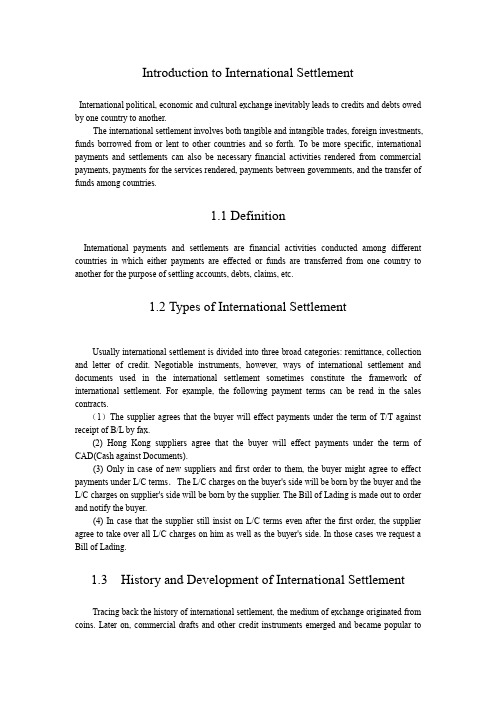
Introduction to International SettlementInternational political, economic and cultural exchange inevitably leads to credits and debts owed by one country to another.The international settlement involves both tangible and intangible trades, foreign investments, funds borrowed from or lent to other countries and so forth. To be more specific, international payments and settlements can also be necessary financial activities rendered from commercial payments, payments for the services rendered, payments between governments, and the transfer of funds among countries.1.1 DefinitionInternational payments and settlements are financial activities conducted among different countries in which either payments are effected or funds are transferred from one country to another for the purpose of settling accounts, debts, claims, etc.1.2 Types of International SettlementUsually international settlement is divided into three broad categories: remittance, collection and letter of credit. Negotiable instruments, however, ways of international settlement and documents used in the international settlement sometimes constitute the framework of international settlement. For example, the following payment terms can be read in the sales contracts.(1)The supplier agrees that the buyer will effect payments under the term of T/T against receipt of B/L by fax.(2) Hong Kong suppliers agree that the buyer will effect payments under the term of CAD(Cash against Documents).(3) Only in case of new suppliers and first order to them, the buyer might agree to effect payments under L/C terms.The L/C charges on the buyer's side will be born by the buyer and the L/C charges on supplier's side will be born by the supplier. The Bill of Lading is made out to order and notify the buyer.(4) In case that the supplier still insist on L/C terms even after the first order, the supplier agree to take over all L/C charges on him as well as the buyer's side. In those cases we request a Bill of Lading.1.3History and Development of International SettlementTracing back the history of international settlement, the medium of exchange originated from coins. Later on, commercial drafts and other credit instruments emerged and became popular tomeet the needs of the constantly increasing business activities in both geographical regions and volume of the international trade.Depending on the creditability of financial institutions, both buyers and sellers are usually willing to complete their settlement through banks respectively, and a financial arrangement could be reached then. Therefore, many banks have focused on their business of international settlement and trade finance.Most of the international payments originate from transactions in the world trade. With the enormous amount of international trade activities, the volume of the international settlement has reached trillions of US dollars nowadays. Banks; as a result, are focusing more and more on the development of the business because it is a major resource of profit.1.4 International Customs and PracticesThe International Chamber of Commerce is the world business organization. It is the only representative body that speaks with authority on behalf of enterprises from all services in every part of the world.(1)International Practices concerning Bills: Bill of Exchange Act, 1882, Jeva Uniform Bill Act.(2) International Practices concerning Settlement:(Uniform Rules for Collection, ICC Publication No: 522), Uniform Customs and Practice for Commercial Documentary Credits,1993 Revision, ICC Publication No. 500).(3) International Practices concerning Documents: Hague Rules, Hamburg Rules, International Convention Concerning the Transport of Goods by Rail, Agreement on International Rail-Road through Transport of Goods, Uniform Rules for a Combined Transport Documents, Institute Cargo Clauses, ICC, International Rules for Interpretation of Trade Terms, Incoterms2000 and UNCITRAL Arbitration Rule.Instruments2.1General IntroductionBills of Exchange, cheques, and promissory notes are all known as negotiable instruments. It is a fundamental principle of property law that we cannot obtain a better title than that possessed by the person from whom we received it. There is always the risk that that person has no title to the property because he has stolen it or obtained it from some other person who got improperly. The true owner, on discovering the property and proving his right to it, can demand the property be restored to him. Our remedy is to look for the person from which we received the property and try to get our money back. That person will in turn claim from his immediate transferor, this tracing right goes on up to the unfortunate one who bought the property from the thief.2.2 Bills of Exchange2.2.1 DefinitionA Bill of Exchange (draft) is a commercial instrument. It is an unconditional order in writing, addressed by one person to another,signed by the person giving it,requiring the person to whom it is addressed to pay on demand,or at a fixed or determinable future time,a sum certain in money,to or to the order of a specified person or to the bearer.A typical Bill of Exchange is drawn in this manner(see Specimen 2.1)·Note:●An unconditional order in writing.●Addressed by one person (the drawer).●To another (the drawee).●Signed by the person giving it.●Requiring the person to whom it is addressed.、、●To pay.●On demand or at a fixed or determinable future time.● A sum certain in money:●To or to the order of a specified person or the bearer.2.2.2 Liability on Bills of ExchangeThe liability on a Bill of Exchange is by signature only: no signature, no liability. In another words, no person is liable as drawer, endorser or acceptor of a bill who has not signed.2.2.3 Endorsement of Bills of ExchangeFor many commercial contracts, the benefits of the contract may be transferred from one person to another. With a Bill of Exchange, this transfer is effected by delivery, or by endorsement and delivery. Endorsement is a signature and a signature must be the same with the transferor's name as stated on the bill. It is normally on the back of the document. There are four types of endorsement: blank, special, restrictive or conditional.2 .2.4 Acceptance of Bills of Exchange The drawee has no liability on the bill until he signs the bill in ,such a way as to signify acceptance of liability to pay the money stated on the bill. The acceptance of a bill is the signification by the drawee of his assent to the order of the drawer. An acceptance is invalid unless it complies with the following conditions, namely:(1)It must be written on the bill and signed by the drawee. The mere signature of the drawee, without additional words, is sufficient.(2) It must not express that the drawee will perform his promise by any other means than the payment of money.Acceptance may be made before signature by the drawer. It may also be accepted when overdue or when previously by non-acceptance or non-payment.2.2.5 Holders of Bills of Exchange.A holder for value is the holder of bill for which value has been given: he is a holder for value as regards all parties prior to himself. Once value is given for a bill, the-holder giving value and all subsequent holders are holders for value. A holder for value has the right of transferability conferred upon him by the common law. He has exactly the same rights together, with faults andfailings, if any, of the person who transferred the bill to him.2.2.6Duties of Holders of a Bill of ExchangeA Bill of Exchange holder must do two things:present the bill for acceptance and present the bill for payment. The holder must carry out his duties. Alternatively, he can transfer the bill to another person, within a "reasonable time" of receiving the bill.Presenting the bill for acceptance is personal. The bill is presented to the drawee personally for acceptance, wherever he is. In so doing, the holder gains an extra signature and thereby an extra liability on the bill. If the drawee refuses to accept the bill, the bill is then dishonored by non-acceptance and the holder can immediately sue all prior parties to the bill.Presentment for payment is local, meaning that the bill must be presented at the right place whether or not the person liable on the bill is at that place. The right place is the place stated on the bill as being the place of payment, otherwise the bill should be presented at the place of business or the place of the drawee/acceptor. The payment should be presented during business hours.2.2.7 Liability of Drawers,Drawees and Endorsers(1)Liability of DrawersBy drawing the bill the drawer commits himself to the following:a. That it will be duly accepted or paid on presentment, andb. That if it is dishonored he will compensate the holder or any endorser for any loss suffered.(2) Liability of DraweesBefore acceptance, the drawee is not liable to any holder (though he may be personally liable to the drawer if he dishonors a bill properly drawn upon him).After acceptance, the drawee becomes the person primarily liable on the bill, and engages that he will pay the bill according to the terms of his acceptance.(3) Liability of EndorsersAny person who endorses a bill makes a commitment that it will be duly paid upon presentment. If the bill is dishonored he will compensate the holder who is compelled to pay it.2.2.8 Dishonor of Bills of ExchangeIf a bill is dishonored by non-acceptance or non-payment, the holder must inform all prior parties that the bill has been dishonored. If such notice has not been given within a reasonable time, all prior parties except the person primarily liable on the bill will cease to be liable to the holder. The person primarily liable on the bill is the drawer. Once the bill is accepted, the acceptor assumes primary liability.2.3 Cheques2.3.1 DefinitionA cheque is an unconditional order in writing, addressed by a person to a bank, signed by the person making it, requiring the bank to pay on demand a sum certain in money to onto the order ofa specified person or to the bearer.2.3.2Parties to a ChequeThree parties are essentially involved:●The Payee, a person to whom a cheque is expressed to be payable.●The Drawer, the person who writes the cheque.●The Drawee, the bank on whom the cheque is drawn and to whom the order to pay isgiven.2.3.3 SignatureAn agent may sign a cheque if he is authorized. For example; a bank officer may sign on behalf of the bank for which he works provided he is an authorized signatory.2.3.4 ForgeryIf the drawer has not signed (and he cannot truly have done that if his signature has been forged), then the document without the drawer's signature is not a cheque.For example, if John Black steals Wolf Smith's cheque book, forges Mr. Smith's signature to a cheque USDS,000 and presents it to the bank on which it is drawn and obtained payment, the bank cannot debit Mr. Smith's account with it, for the bank's only authority to debit the account is Mr. Smith's genuine signature. The bank would lose the money unless the forgery was immediately discovered after payment. However, if the bank had paid the forger John Black,then its only right would be against the forger, for what it was worth.2.4 Promissory Notes2.4.1 DefinitionA promissory note is an unconditional promise in writing, made by one person (the maker)to another (the payee or the holder), signed by the maker, engaging to pay on demand or at a fixed or determinable future time a sum certain in money, to or to the order of a specified person or to bearer.A promissory note is a promise, and a bill is an order. There is no need to protest a dishonored note. And as the maker of a promissory note is the person primarily liable on it, there can be no acceptance.A promissory note is not complete when the maker signs it. It must also be delivered to the payee or bearer.A typical promissory note is made in this manner (see Specimen 2.3).Note:●An unconditional promise in writing.●The maker.●The payee or the holder.●Engaging to pay.●On demand or at a fixed or determinable future time.● A sum certain in money.2.4.2 Liability of MakersThe maker of a promissory note should be engaged in the payment according to its tenor, and is precluded from denying to a holder in due course the existence of the payee and his then capacity to endorse.2.4.3 Banker's DraftsA banker's draft is a negotiable instrument drawn payable to order by a bank as drawer on the same bank as' drawee, in another word, the drawer and drawee are the same person. It is issued by a bank for certain fixed amounts, always payable to bearer and on demand. Even though the draft may be drawn by a branch of head office or another branch; and the bank is considered as one entity for this purpose. It is also a legal tender.It goes without saying that a banker's draft is as good as cash for many commercial purposes, dishonor of it being unheard of unless it is known that the presenter is not entitled to it.Remittance and Collections3.1 DefinitionRemittance refers to the transfer of funds from one party to another among different countries through banks. At the request of its customer, a bank transfers a certain sum of money to its overseas branches or correspondent banks and instructs them to pay a named person or corporation in that country.3.2 Means or Instruments of RemittanceThe remittance will be done by several means or instruments such as mail transfer, demand draft and telegraphic transfer. The instruments mentioned above bear their characteristics, which will be discussed later.3.2.1 Mail Transfer (M/T)A mail transfer is to transfer funds by means of a payment order or a mail advice, or sometimes a debit advice issued by a remitting bank, at the request of a remitter. Either of a payment order, mail advice or debit advice must be authenticated with tested key or the authorized signatures of the remitting bank. It instructs the paying bank to pay a certain sum of money to the beneficiary. Upon receipt of the payment order, the paying bank verifies the tested key or the authorized signature, notifies the beneficiary, pays to him and claims reimbursement from the remitting bank. In practice, the remitting bank credits the account for the paying bank in the remitting bank.3.2.2 Demand Drafts(D/D)A demand draft is often used when the customer wants to transfer the funds to his beneficiary by himself. The remitter will make a written request of issuance to the remitting bank. Then the remitting bank debits the remitter's account, issues a bank draft and forwards it to the remitter who may send or carry it abroad to the payee. Upon receipt of the draft, the payee can either present it for payment to the drawee’s bank or sell it to his own bank crediting his account. The drawee's bank verifies the signature, pays the draft and claims back the amount paid in accordance with itsagency arrangement with the remitting bank.3.2.3Telegraphic Transfer(T/T)Telegraphic transfer refers to remittance by SWIFT. It is exactly the same as a mail transfer, except that instruction from the remitting bank to the paying bank is transmitted by cable/telex/SWIFT instead of by mail. Therefore, it is faster, but more expensive than the mail transfer. It is often used when the remittance amount is large and the transfer of funds is subject to a time limit. Thus, 90% remittance is done through T/T.Table 3.1 Comparison among T/T,MT and D/D3.2.3 Collections3.3.1 DefinitionAfter the exporter has shipped the goods or rendered services to his customers abroad, he draws a Bill of Exchange on the latter with or without shipping documents attached thereto and then gives the draft to his bank together with his appropriate collection instructions. Thus, a collection on the basis of commercial credit is usually processed through banks acting as the intermediary.3.3.2 Workflow(1)The exporter ships goods and obtains documents of title from the shipping line.(2) The exporter, known as the principal, delivers the following documents to his bank (remitting bank): a. a Bill of Exchange drawn on the importer; b. documents for goods of title and c. a collection order which contains the exporter's instructions to the remitting bank.(3) The remitting bank completes its own collection order addressed to the importer's bank.(4) If the instructions are D/P (documents against payment), the importer's bank will release the documents to the importer only against payment. If the instructions are D/A(documents against acceptance), the importer's bank will release the documents against acceptance of the Bill of Exchange by the importer.(5) The bank credits the proceeds to the principal's account.3.3.3 Documentary Collections(1)DefinitionA documentary collection is an operation in which a bank collects payment on behalf of the seller (the principal) by delivering documents to the buyer.Documentary collections are suitable in cases where the exporter is reluctant to supply the goods on an open account basis, but does not need the strong security provided by a documentary credit. A documentary collection is more secure than settlement on open account, because the importer can take possession of the goods with either making payment or accepting a Bill of Exchange. The banks concerned are under no obligation to pay. The exporter is relieved of a large part of the administrative work connected with the collection of documents, and benefits from the banks’worldwide network of contacts. Thanks to the less stringent formal requirements, this service is cheaper and more flexible than a documentary credit.With a documentary collection, however, the exporter is not certain, at the time of dispatch of the goods whether the buyer will actually make the full payment. This form of settlement is therefore most appropriate in the following cases:●the exporter has little doubt about the buyer's willingness and ability to pay;●the political, economic and legal environment in the importing country is considered tobe stable;●the buyer's country has placed no restrictions on imports (e.g. exchange controls).(2) Types of Documentary Collectionsa. Documents against Payment (D/P)The presenting bank is authorized to release the documents to the drawee only against immediate payment. That means the payment should be effected on first presentation of the documents. Sometimes there is no draft in the documentary collection due to the levy of stamp duty.b. Documents against Acceptance (D/A)The presenting bank releases the documents to the importer against his acceptance of a Bill of Exchange, which is usually payable 30-180 days after sight or at a fixed future date. The presenting bank must ensure that the acceptance of the Bill of Exchange is complete and correct. However, the presenting bank bears no responsibility for the authenticity of the signature, the authority of the signatory to sign or the creditworthiness of the acceptor.With a D/A arrangement, the importer takes possession of the goods before payment is actually effected. Once the goods have been released, the exporter's only safeguard is the Bill of Exchange accepted by the importer.c. Acceptance with, Documents against PaymentWith this type of documentary collections, the exporter gives instructions that the importer, when presented with the documents, shall accept a Bill of Exchange drawn at, say, 60 days aftersight. The documents may not, however, be released to the importer until the bill has been paid. In other words, the release of documents is made against payment of tenor drafts.Acceptance. with documents against payment is not encouraged by International Chamber of Commerce.3.3.4 Uniform Rules for Collections(URC)The Uniform Rules for Collections (URC) form an internationally accepted code of practice covering documentary collections. URC are not incorporated any national or international law, but are normally binding on all parties because all bank authorities (especially the collection instruction) will state that the collection is subject to URC (ICC Publication No: 522, URC522).URC522 will apply unless the collection instruction states otherwise or the laws in one of the countries concerned specifically contradict them.3.3.5 Collection InstructionsHaving dispatched the goods and prepared the documents, the exporter is ready to request his bank to arrange a collection. The specimen of collection. instruction is a standard form which enables the exporter to include specific instructions to his bank regarding the documentary collection. The collection instruction must be clear and complete, since the handling of the transaction by the remitting and collecting banks will be governed solely by the instructions contained in the collection instruction. The most important parts included in the collection instruction are instructions regarding documents and payments.(1)Instructions to Release Documentsa. D/A refers to the release of documents against acceptance of tenor drafts. The collecting bank will fulfill his obligation when the documents are delivered upon the acceptance of the draft.b. D/P refers to the release of documents against payment of sight drafts or simply against payment.c. D/P at xx days after sight refers to the release of documents against payment of tenor drafts. In order to avoid confusion with the operation of D/A, the statement "Deliver documents only after payment was effected" should be written into the collection instruction.(2) Instructions to Effect PaymentOne of the following three options of collection instructions may be chosen:a. When the remitting bank has an account with the collecting bank, the collection instruction will be “please credit our account with you under you SWIFT/airmail advice to us".b. When the collecting bank has an account with the remitting bank, the collection instruction will be "please collect the proceeds and authorize us by SWIFT/airmail to debit your account with us".c. When there is no account relationship between the remitting bank and the: collecting bank, the collection instruction will be "please collect and remit the proceeds to X Bank for credit our account with them under their SWIFT/airmail advice to us".(3) Additional Instructionsa. The collection instruction should give specific instructions about whether or not to protest in the event of non-payment or non-acceptance. If the importer refuses to pay or to accept the Bill of Exchange when the documents are presented, the presenting bank must send notice of this to the exporter through the remitting bank.The bank will not institute a protest unless expresslyinstructed to do so.b. The exporter should give the name and address of a representative or agent in the country of importer who will be responsible for the warehousing and resale of goods in the event of non-payment. The collection instruction should specify if there is a party known as the "case of need". If a case of need is named, the collecting bank will refer to him in the event of dishonor for guidance or instruction.3.3.6 Legal Position of Banks(1)Duties of Remitting BanksThe bank's legal liability is set out in the Uniform Rules for Collections. Banks must verify that the documents received comply with the one specified in the collection instruction, and carryout the instructions given by the principal.a. Documents ProcessingBanks have no responsibility to examine the documents thoroughly. The remitting bank will make additional checks before sending them to collecting bankb. International Practice in Conducting the BusinessFor matters not mentioned in the collection instruction, the remitting bank should handle the collection business in compliance with the international practice in terms of those unmentioned in the collection instruction. For instance, under URC522, Article 5 (d),remitting bank may choose collecting bank for the principal if no collecting bank is named in the collection instruction.In addition, banks assume no liability in case the instructions they transmit are not carried out, even if they have taken the initiative in choosing such banks according to URC522, Article11(b).Moreover, according to URC522, Article 4(a), all the documents sent for collection must contain complete and precise collection instructions, including one specifying that the collection is subject to URC522.c. Liability for NegligenceUnder URC522, banks shall act in good faith and excise reasonable care. Banks will be liable for the loss caused by negligence on the part of the bank: For example, the remitting bank fails to inform the principal of the refusal of payment from the collecting bank in time, and thus causes loss to the principal. Also, the remitting bank is responsible for the documents sent to the collecting bank by wrong address.(2) Duties of Collecting Banksa. Implementation of Collection InstructionsUsually there is a correspondent relationship between remitting bank and collecting bank, and correspondent agreements are signed by them. Collecting bank handles the collection business according to the collection instruction. According to URC522, Article 4, collecting banks are only permitted to act upon the instructions given in such collection instruction and in accordance with URC522.Any deviation from these instructions at the request of importer will be at the peril of the collecting bank.If the collection instruction is unclear, the collecting bank should contact the remitting bank timely and wait for the further instruction. If the collecting bank finds it difficult to follow up the instruction given by the remitting bank, e.g. goods consigned to the collecting bank without prior agreement, the collecting bank can ignore it. The collecting bank has no obligation to take delivery of goods, which remain at the risk and responsibility of the party dispatching the goods uponURC522, Article 10.b. Documents HandlingAccording to URC522, Article 12, the collecting bank must verify that the documents received are in order as they are listed in the collection instruction and must advise by telecommunication or, if that is not possible, by other expeditious means without delay, the party from whom the collection instruction was received of any documents missing or found to be other than listed. The collecting bank has no further obligation in this respect. Documents are to be presented to the importer in the form in which they are received according to URC522,Article 5.The advice from the collecting bank which forwards to the importer is accompanied by photocopies of the documents. These provide the importer with essential facts about the goods that have been sent and tell him whether the documents received by the bank will enable him to take delivery of the goods and clear them through customs. The importer may go to the bank's offices and examine the papers. The bank, however, is not allowed to let him inspect the goods at the place of destination without authorization from the exporter.With a D/A transaction, the accepted Bill of Exchange either remains with the collecting bank or is returned to the remitting bank, depending on the instructions given by the exporter. In the latter case, the remitting bank delivers the bill to the exporter, who can either discount it or have it collected at maturity. In the case of medium-term maturity, there may be the possibility of selling the bill to a forfeiter or using it as security for a bank advance. The collecting bank should be responsible for keeping the accepted Bill of Exchange and the documents before the payment is effected by the importer:c. Protection of GoodsAccording to URC522, Article 10, in the event that goods are dispatched directly to the address of a collecting bank or to the order of a collecting bank for release to an importer against payment or acceptance or upon other terms and conditions without prior agreement on the part of that bank, such bank will have no obligation to take delivery of the goods, which remain at the risk and responsibility of the party dispatching the goods. Even when specific instructions are given to the collecting bank to take actions in respect of the goods to which a documentary collection relates, including storage and insurance of the goods, the collecting bank has no obligation to do so, and it should advise the remitting bank accordingly. However, in the case that the collecting bank takes action for the protection of the goods, whether instructed or not, it assumes no liability with regard to the condition of the goods, or any acts and omissions on the part of any third parties entrusted with the custody or protection .of the goods. But the collecting bank must inform without delay the bank from which the collection instruction was received of any such action taken.(3) Liability of Collecting Banksa. Documents ReleaseUnder URC522, Article 19, partial payment in documentary collections will be accepted only if specifically authorized in the collection instruction. Otherwise, the collecting bank will release the documents to the importer only after full payment has been received, and the collecting bank will not be responsible for any consequences arising out of any delay in the delivery of documents.b. Completeness and Correctness of Bill AcceptanceThe collecting bank is responsible for ensuring that the form of the acceptance of a Bill of。
《国际结算》(双语)教学大纲
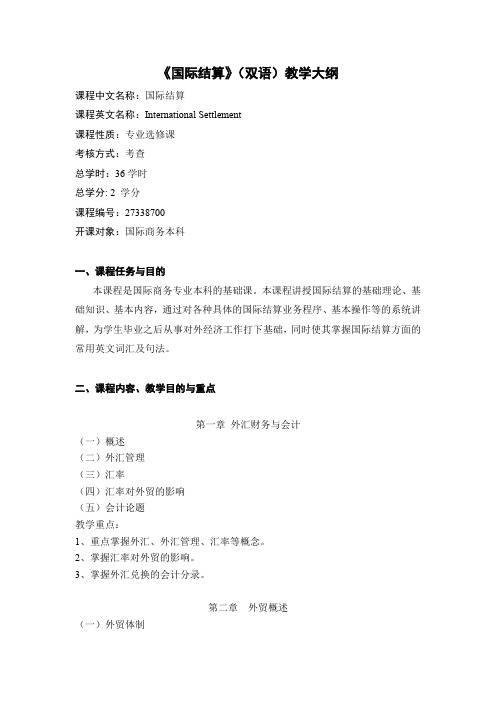
《国际结算》(双语)教学大纲课程中文名称:国际结算课程英文名称:International Settlement课程性质:专业选修课考核方式:考查总学时:36学时总学分: 2 学分课程编号:27338700开课对象:国际商务本科一、课程任务与目的本课程是国际商务专业本科的基础课。
本课程讲授国际结算的基础理论、基础知识、基本内容,通过对各种具体的国际结算业务程序、基本操作等的系统讲解,为学生毕业之后从事对外经济工作打下基础,同时使其掌握国际结算方面的常用英文词汇及句法。
二、课程内容、教学目的与重点第一章外汇财务与会计(一)概述(二)外汇管理(三)汇率(四)汇率对外贸的影响(五)会计论题教学重点:1、重点掌握外汇、外汇管理、汇率等概念。
2、掌握汇率对外贸的影响。
3、掌握外汇兑换的会计分录。
第二章外贸概述(一)外贸体制(二)国际商会《国际贸易条款》(2000版)教学重点:1、重点掌握国际商会《国际贸易条款》中对13种“贸易术语”的解释。
2、掌握我国外贸体制的发展变化。
第三章运输和运费(一)运输业务系统(二)单证(三)运费教学重点:1、重点掌握海运提单概念、作用、关系人及其提单的背书转让。
掌握提单正面和提单签字人的要求,掌握提单的清洁问题。
2、重点掌握不可流通转让海运单与海运提单的区别。
3、了解租船合约提单的定义、作用。
4、掌握多式运输的形成。
重点掌握多式运输单据与海运提单的区别。
5、掌握不同运输方式适用的贸易条件。
第四章保险(一)概述(二)风险和保险覆盖范围(三)单证(四)保险费的计算(五)运费和保险费的会计处理教学重点:1、重点掌握保险风险和保险覆盖范围。
2、重点掌握保险单据的定义与分类。
3、掌握保险费的计算。
4、掌握运费和保险费的会计处理。
第五章税务(一)关税(二)流转税——增值税(三)消费税(四)营业税教学重点:1、重点掌握关税的概念、计算。
2、掌握外贸中流转税——增值税的计算、出口退税的原理及其会计处理。
国际结算(双语)
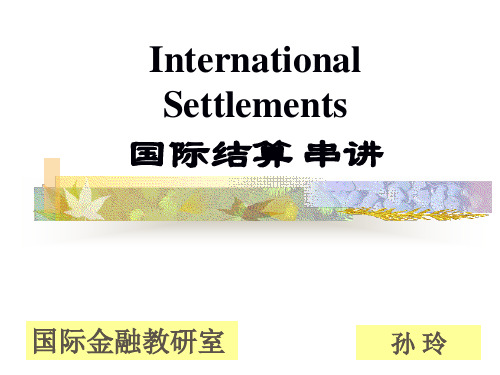
EXW
FCA
EX WORKS(…named place)工厂交货条件
FREE CARRIER(… named place)交至承运人条件
FAS
FOB
FREE ALONGSIDE SHIP (… named port of shipment)船边交货条件
FREE ON BOARD (… named port of shipment)装运港船上交货条件
A Bank
Current a/c XXX
B Bank
B Bank‟s currency
Nostro A/C XXX is A Bank‟s __________________a/c
Exercise:
Current a/c XXX
A Bank
B Bank
A Bank‟s currency
Vostro A/C XXX is A Bank‟s __________________a/c,
Establish a correspondent relationship between two banks.
Agency arrangement Control documents
What do control documents include?
Control Documents
Lists of specimen of authorized signatures 印鉴 是银行列示的所有有权签字的人的有权签字额度、签字范围、 有效签字组合方式以及亲笔签字字样。代理行可凭其核对对 Verify the messages, letters(airmailed) are 方银行发来的电报、电传等的真实性。 authentic Telegraphic test keys密押 Verify the telex and cable are authentic 是两家代理行之间事先约定的专用押码,在发送电报时,由
《国际结算(英)》教学大纲
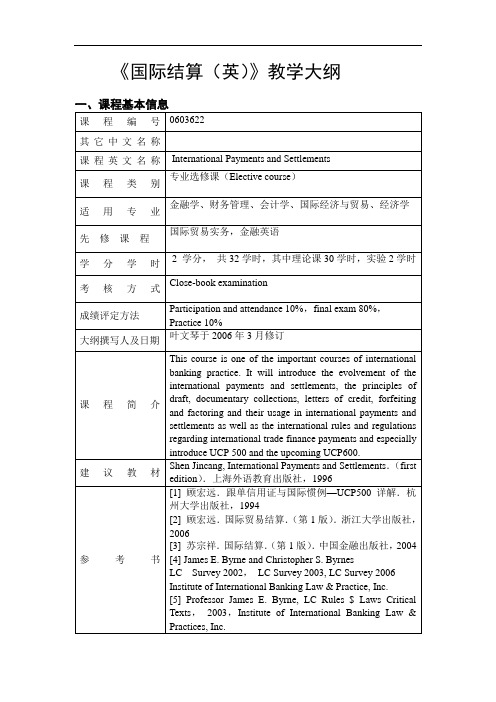
《国际结算(英)》教学大纲二、The feature and students of the courseThe course is open for the students majoring in International Finance, Accounting and International Trade. It will provide the students with a comprehensive overview of bank practices in international payments and settlements and introduce various techniques in international trade finance.三. The aim and requirements of the courseAim of the course:The overall aim of this course is to develop the students’understanding in international payments and settlements and to increase the students’ ability to conduct international banking practices. The students will develop a better understanding of the advantages as well as the risks involved in using these payments methods. By the end of the course, the students will be able to understand the documentation, international rules and regulations regarding international trade finance; to understand the principles of letter of credit, documentary collections, drafts, etc.; to understand the different types of letters of credit and their usages in practice. This course will also keep the students well informed of the latest developments in international finance.Requirements:In the course,the students are required to be able to draw a draft, issue and examine documents under a letter of credit, and apply the terms of UCP 500 and the upcoming UCP600 to analyze cases.四、Method of teachingThis course is mainly delivered by lectures and incorporates the use of exercises, cases and discussions.五、Content of the course and time allocationChapter One IntroductionClass hour :1Requirements:This chapter will make a general introduction of the course , the rough content of the international trade finance and its evolvement. The students are required to be familiar with the characteristics of the course and the main terms of trade such as in intercom 2000.Priority: feature of the international payments and settlementsContent:1.What are international payments and settlements2.Evolution of international payments and settlements3.Basic points for attention in international payments and settlements4.Characteristics of modern international payments and settlementsChapter Two Credit InstrumentsClass hour: 1Requirements:to understand the features, function and the parties of the negotiable instruments and to have a good grasp of the principle of the negotiable instruments.Priority:negotiation of instrumentContent :1.Characteristics of a negotiable instrument2.Functions of a negotiable instrument3.Parties to a negotiable instrumentChapter Three Bill of Exchange---Definition, Acts Class hour: 2Requirements:to learn the definition, principle and acts of the draft.Priority:feature of a bill of exchangeContent:1.What is a bill of exchange: As defined in the Bills of Exchange Act 1882 of the United Kingdom, a bill of exchange is an unconditional order in writing addressed by one person to another, signed by the person giving it, requiring the person to whom it is addressed to pay on demand or at a fixed or determinable future time a sum certain in money to or to the order of a specified person or to bearer.2.Acts of a bill of exchangeIssueEndorsementPresentmentAcceptancePaymentDishonourNotice of dishonourProtestRight of recourseAcceptance for honour supra protestPayment for honour supra protestGuaranteeChapter Four Bill of Exchange---Lost Bill, Discounting, Acceptingand Forfaiting a Bill, ClassificationClass hour:1.5Requirements:to grasp the discounting and acceptance of a draft and identify various types of draft.Priority:discounting and acceptance of a bill of exchangeContent:1.Lost bill of exchange2.Discounting, accepting and forfeiting a bill of exchange3.Classification of a bill of exchangeChapter Five Promissory NoteClass hour: 0.5 hourRequirements:have a better understanding of the feature of a promissory note and distinguish the difference of promissory note and draft.Priority: difference from bill of exchangeContent:1.What is a promissory note2.Characteristics of a promissory note3.Essentials to a promissory note4.Difference between a bill of exchange and a promissory noteChapter Six ChequeClass hour: 1Requirements:to understand the feature of a cheque and distinguish it from a draft.Priority:feature of a chequeContent:1.What is a cheque2.Essentials to a cheque3.Features of a cheque4.Countermand of payment5.Wrongful dishonour of a cheque6.Crossed cheques7.Difference between a bill of exchange and a chequeChapter Seven Correspondent Banking Relationships Class hour: 1Requirements:to realize the importance and necessity of establishing correspondent relationship.Priority:control documentsContent:1.Correspondent bank, branch, representative office, agency, banking subsidiary and affiliate2.Why establish correspondent banking relationship3.Which banks should become the correspondents4.How to establish correspondent banking relationship5.Control documents6.Expanding international banking business with the aid of foreign correspondentsChapter Eight RemittanceClass hour: 1Requirements:to understand the principle of remittance and the practices.Priority:advantage and disadvantage of remittanceContent :1.Parties related to a remittance2.Accounts between international banks3.Ways of transfer4.Methods of reimbursement5.Cancellation of the remittance6.Advantages and disadvantages of different ways of transferChapter Nine Terms and Methods of Payment in InternationalTrade---Payment in Advance, Open Account Business, Factoring,CollectionClass hour:2Requirements:have a better understanding of various methods of payment.Priority:factoring and collectionContent :1.Payment in advance2.Open account business3.Factoring4.CollectionWhat is a collectionParties to a collectionTypes of collections: Documents against payment (D/P)Documents against acceptance (D/A)Collection procedureRisks and advantages of collection methodLiability and responsibility of the banks doing collection businessChapter Ten Terms and Methods of Payment in International Trade-----Letters of Credit(L/C)Class hour: 6Requirements:to understand the principle of the letters of credit, to be acquainted with the rights and obligations of various parties of the L/C. to understand the features of different types of letters of credit and the procedure of issuing and usage of a credit and the practice of amendment of a credit.Priority:Characteristics of a letter of creditContent:1.What is L/C2.Characteristics of a letter of credit3.Functions, advantages and disadvantages of a letter of credit4.Parties to a letter of credit5.Contents of a letter of credit6.Classification of letters of creditDocumentary credit:Irrevocable creditConfirmed creditUnconfirmed creditSight creditUsance or time creditPayment creditDeferred payment letter of creditAcceptance letter of creditNegotiation creditRevolving creditTransferable creditBack to back letter of credit7.Procedures of letter of credit operations8.Amendment under a letter of creditChapter Eleven Terms and Methods of Payment in InternationalTrade---Letters of GuaranteeClass hour: 1Requirements:to understand the feature of a letter of guarantee, and its difference from a letter of credit. To be familiar with various types of letters of guarantee.Priority:nature of a letter of guaranteeContent:1.Nature of demand guarantee2.Parties to a letter of guarantee3.Contents and clauses under a guarantee4.Types of guarantees5.Points for attention in establishing a letter of guarantee6.Forms of a letter of guarantee7.Difference between a letter of guarantee and a letter of credit8.Cancellation of a guarantee9.Standby letter of creditChapter Twelve Documents-Draft, Invoice, Insurance PolicyClass hour: 1Requirements:to understand the feature of various documents, content and their functions and learn to make and examine various documents.Priority:to draw a draftContent:1.Draft2.Invoice3.Insurance policy or certificateChapter Thirteen Documents---Air Waybill, Road Waybill, Cargo Receipt, Parcel Post Receipt, Bill of LadingClass hour: 3Requirements: to understand the three functions of ocean B/L and distinguish it from other transport documents.Priority: Characteristics of the ocean B/LContent:1.Air waybill2.Road waybill, consignment note3.Cargo receipt, railway bill4.Courier receipt and post receipt5.Bill of ladingWhat is a bill of ladingThe functions of a bill of ladingParties to a bill of ladingTypes of bill of lading(1)Shipped on board bill of lading(2)Received for shipment bill of lading(3)Direct bill of lading(4)Transshipment bill of lading(5)Straight bill of lading or named consignee bill of lading(6)Order bill of lading, or negotiable bill of lading(7)Clean bill of lading and unclean bill of lading(8)Stale bill of ladingChapter Fourteen Documents—Combined Transport Documents,Miscellaneous DocumentsClass hour: 2Requirements:to understand multi-mode transportation documents and various export documents.Priority:combined transport documents and the difference between CTD and ocean B/LContent:bined transport documents2.Miscellaneous documentsConsular invoiceCertificate of origin and A GSP Certificate of origin Form ACustoms invoiceInspection certificatePacking listBeneficiary’s statementChapter Fifteen Documents examination and ReimbursementClass hour: 2Requirements:learn to examine documents against L/C and learn how to handle discrepant documents so as to better understand and apply UCP500 or upcoming UCP600.Priority:to grasp the skill of examining documentsContent:1.General principle2.Examining a draft3.Examining a commercial invoice4.Examining a certificate of origin5.Examining Marine Insurance Documents6.Examining a bill of lading7.Examining other documents8.Most common discrepancies9.Bank’s common practice if the documents presented do not meet the credit requirement10.Payment refused by the issuing bank11.Payment and reimbursement under a letter of creditChapter Sixteen Supplementary material: Uniform Customs and Practice for Documentary Credits-----1993 Revision (Publication No.500)Class hour: 4Requirements:In order to be familiar with the international regulations and uniform practices, we require the students to understand the mains articles of UCP 500 and learn application of the terms in banking practice.Content:all the articles of UCP 500 and introduction of upcoming UCP 600六. Practice and case discussionRequirements: In order to let students have an real experience in bank’s documentary credit operation, we’ll organize the students to issue a set of shipping documents according to an L/C and examine the documents. Finally the students will have a seminar dealing with cases of L/Cs subject to UCP 500.Class hour: 2 hours。
国际结算(双语版)

2.1.1 Definition of Remittance 2.1.2 Basic parties of Remittance
1. Remitter and payee 2. Remitting bank and paying bank 2.1.3 Characteristics of Remittance 1. High risk. 2. Fast speed and low cost.
Chapter Chapter Chapter Chapter Chapter Chapter Chapter Chapter Chapter Chapter Chapter
1 Negotiable Instrument 2 Remittance 3 Collection 4 Letter of credit 5 Types of letter of credit 6 Introduction of UCP600 7 Documents in credit 8 Standby letter of credit 9 Letter of Guarantee 10 Forfaiting 11 International Factoring
3.2.2 Documents against Acceptance (D/A)
3.3.1 The risk of collection. 1. Risk for seller 2. Risk for buyer 3.3.2 The risk management of collection 3.3.3 Financing under collection 1. Outward bill purchasing 2. Trust Receipt (T/R) 3. Delivery against Bank Guarantee
国际结算双语课程标准--英文版

Practice 2. TT process operation
4
Collection
To understand the definition of collection,be familiar with the international practice,parties and application of collection
International settlement(bilinguacoluisrsme) standard
First, summary of course
It is the core course of international economic and trade major, based on the operating skills’ cultivation about methods of international settlement, combining theory with reality, emphasising on positional operation, paying attention to the cultivation of comprehensive ability about finding, analyzing and solving problems, etc.
1.Definition of standby letter of credit
2.Characteristics of standby letter of credit
3.Differences between standby letter of credit and documentary letter of credit
国际结算英文版课程设计 (2)
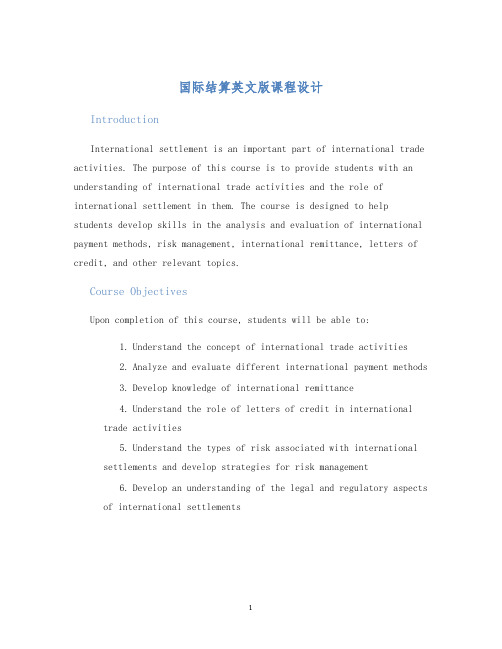
国际结算英文版课程设计IntroductionInternational settlement is an important part of international trade activities. The purpose of this course is to provide students with an understanding of international trade activities and the role of international settlement in them. The course is designed to help students develop skills in the analysis and evaluation of international payment methods, risk management, international remittance, letters of credit, and other relevant topics.Course ObjectivesUpon completion of this course, students will be able to:1.Understand the concept of international trade activities2.Analyze and evaluate different international payment methods3.Develop knowledge of international remittance4.Understand the role of letters of credit in internationaltrade activities5.Understand the types of risk associated with internationalsettlements and develop strategies for risk management6.Develop an understanding of the legal and regulatory aspectsof international settlementsCourse OutlineWeek 1: Introduction to International Settlements•Overview of international trade activities•Introduction to international settlement•International trade-related documents, contracts, and customsWeek 2: International Payment Methods•International wire transfer•Bank drafts and money orders•Online payment methods•Payment through third-party servicesWeek 3: International Remittance•Overview of international remittance•Process for international remittance•Comparison of international remittance methods•Taxation policies in international remittanceWeek 4: Letters of Credit•Introduction and basics of Letters of Credit•Types of Letters of Credit•Advantages and disadvantages of Letters of Credit•Documentation and processing of Letters of Credit Week 5: Risk Management in International Settlements •Risk management strategies•Types of risk in international settlement•Risk assessment tools•Insurance and its typesWeek 6: Legal and Regulatory Framework for International Settlement •Legal and regulatory aspects of international settlements•Legal issues in payment processes•Consumer protection laws•International treaties and regulationsAssessment1.Mid-term exam (30%)2.Final exam (40%)3.Assignments and presentations (20%)4.Class participation and attendance (10%)ConclusionThis course ms to provide students with a thorough understanding of international settlement and its role in international trade activities. Through the content, assignments, and evaluations provided, studentswill be equipped with the necessary knowledge and skills to succeed in the international business world. Upon completion of this course, students will have a well-rounded understanding of the various international payment methods, international remittance, letters of credit, risk management, and the legal and regulatory aspects of international settlement.。
国际结算(双语)国际结算(双语)课件2
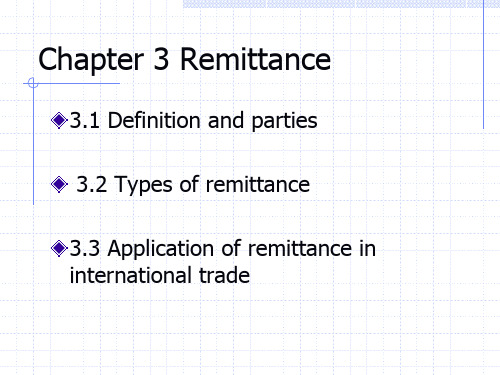
3.1 Definition and parties
3.2 Types of remittance
3.3 Application of remittance in international trade
3.1 Definition and parties
3.1.1 Definition At the request of its customer, a bank
Mail transfer Advice The payment order
Mail Transfer Advice Bank of China, Guangzhou Branch
Please advice and effect the following payment less your charges if any. In cover, we have credit your A/C with us. (you are authorized to debit our account with you.) TO:_______, No. of M/T:______ ,TO be paid to______ Amount:________, Amount in Words:_____________ By order of:_______, Message:___________
Remitter
1
2
proceeds
Payee 5 67
. Payment . receipt .Notification of T/ T
.receipt .T/T application
3. payment order sent by cable or SWIFT
国际结算英文版教学设计 (3)
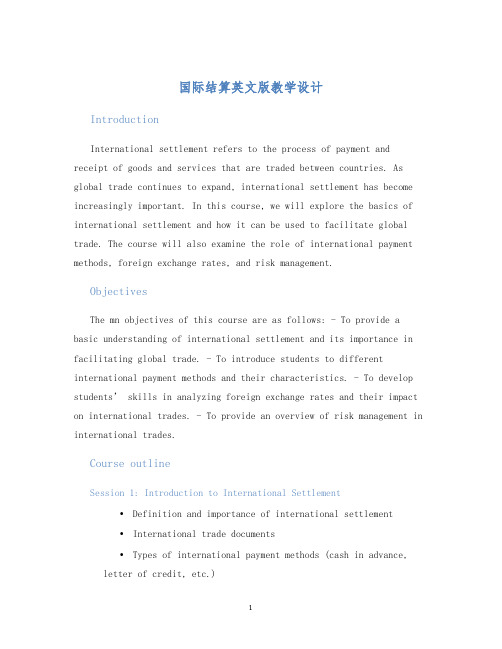
国际结算英文版教学设计IntroductionInternational settlement refers to the process of payment and receipt of goods and services that are traded between countries. As global trade continues to expand, international settlement has become increasingly important. In this course, we will explore the basics of international settlement and how it can be used to facilitate global trade. The course will also examine the role of international payment methods, foreign exchange rates, and risk management.ObjectivesThe mn objectives of this course are as follows: - To provide a basic understanding of international settlement and its importance in facilitating global trade. - To introduce students to different international payment methods and their characteristics. - To develop students’ skills in analyzing foreign exchange rates and their impact on international trades. - To provide an overview of risk management in international trades.Course outlineSession 1: Introduction to International Settlement•Definition and importance of international settlement•International trade documents•Types of international payment methods (cash in advance, letter of credit, etc.)Session 2: International Payment Methods•Cash in advance•Open account•Documentary collections•Letter of creditSession 3: Foreign Exchange Rates•Definition and importance of foreign exchange rates•Examples of foreign exchange rates•Factors affecting foreign exchange ratesSession 4: Foreign Exchange Risk Management•Hedging techniques•Types of foreign exchange risk•Risk management strategiesTeaching methods•Lectures: The instructor will present course materials using PowerPoint slides, including examples and scenarios to enhanceunderstanding.•Case study: Students will work on real-life case studies in class to apply the knowledge learned.•Group discussion: Students will be assigned to groups to discuss and debate the topics covered in class.AssessmentThe assessment for this course will be based on the following: - In-class participation: 20% - Case study report: 30% - Final exam: 50%ConclusionThis course is designed to provide a comprehensive understanding of international settlement, payment methods, foreign exchange rates, and risk management. Students will finish the course with the knowledge and skills necessary to engage in international trades, manage foreign exchange risks, and develop effective payment strategies.。
国际结算中英版

国际结算中英版国际结算1.1 The Concept of International Trade国际贸易的观念International trade is the exchange of goods and services produced in one country for those produced in another country. In most cases countries do not trade the actual the goods and services. Rather they use the income or money from the sale of their products to buy the products of another country.1.2 Introduction to International Payments and SettlementsInternational payments and settlements are financial activities conducted among different countries in which payments are effected or funds are transferred from one country to another in order to clear relations of debts.国际⽀付与结算是指为清偿国际间的债权债务关系或跨国转移资⾦⽽发⽣在不同国家之间的货币收付活动。
1.2 categories(分类)(1)、According to the cause of international settlementInternational trade settlement(国际贸易结算)International trade settlement is created on the basis of sales of commodities.国际贸易结算是指有形贸易活动(即由商品的进出⼝)引起的货币收付活动.(主要形式)International non-trade settlement (国际⾮贸易结算)invisible trade⽆形交易financial transaction⾦融业务payment between governments政府间的款项others 其他业务(2)、According to whether cash is usedCash settlement(现⾦结算)International payments is effected by shipping precious metals taking the form of coins, bars or bullions to or from the trading countries.Non-cash settlement(⾮现⾦结算)International payment is settled by way of transferring funds through the accounts opened in these banks.Four major clearing systems in the world(四⼤清算系统)2.1 SWIFT(Society for Worldwide Interbank Financial Telecommunication)SWIFT is a service organization established to meet a number of specialized service needs relating to interbank financial communications through a dedicated data processing and telecommunication system.Membership 会员制Low expenses 低费⽤Security 安全性Standardised 标准化2.2 CHIPS(The Clearing House Interbank Payment System).纽约清算所同业⽀付系统2.3 CHAPS(Clearing House Automated Payment System)伦敦银⾏同业⾃动⽀付系统2.4 TATGET(Trans-European Automated Real-Time Gross-Settlement Express Transfer)泛欧实时全额⾃动清算系统3.1 Correspondent Bank代理银⾏Correspondent banking is an arrangement under which one bank (correspondent) holds deposits owned by other banks (respondents) and provides payment and other services to those respondent banks. Such arrangements may also be known as agency relationships in somedomestic contexts.是接受其他国家或地区的银⾏委托,代办国际结算业务或提供其他服务,并建⽴相互代理业务关系的银⾏。
- 1、下载文档前请自行甄别文档内容的完整性,平台不提供额外的编辑、内容补充、找答案等附加服务。
- 2、"仅部分预览"的文档,不可在线预览部分如存在完整性等问题,可反馈申请退款(可完整预览的文档不适用该条件!)。
- 3、如文档侵犯您的权益,请联系客服反馈,我们会尽快为您处理(人工客服工作时间:9:00-18:30)。
1
1
remittance, master the types and business process of remittance
attention of remittance
Practice 2. TT process operation 1. International practice of
letter of guarantee 5. business process of Baker’s letter of guarantee
1. Definition of standby letter of credit 2. Characteristics of standby letter of credit 3. Differences between standby letter of credit and documentary letter of credit 1
er the content and the business process of baker’s letter of guarantee To understand the definition and characteristics of standby letter of Standby letter of credit credit, be familiar with the differences between standby letter of credit and documentary letter of credit To understand the definition, function and types of all Types of documents kinds of documents, master the content of documents Be familiar with Documents Situation3 related to international settlement Provisions of the documents about UCP600 the provisions about conditions changing into documents, master the provisions of person which has issued, original、 copy and signature , issuance date of d ocuments,date and method of presentation
Situation 1
instrument
exchange
Practice 1. Made out a bill of exchange To understand the definition of a promissory the types of Promissory notes a promissory note and the differences between it and a bill of exchange, master the essentials of a promissory note To understand the definition of a cheque, be familiar with the Cheques types of a cheque and the differences between it and a cheque,master the essentials of a cheque To understand the definition of Methods of international Situation 2 settlement Remittance remittance、 reimbursing and returning remittance be familiar with the parties and application of the 1. Definition of remittance 2. Parties of remittance 3. Types and business process of remittance 4. Reimbursement and return of remittance 5. Application and 3. Differences between a cheque and a bill of exchange 4. Types of a cheque 1. Definition of a cheque 2. Essentials of a cheque 3. Differences between a promissory note and a bill of exchange 4. Types of a promissory note not e, be familiar with 1. Definition of a promissory note
2
To understand the definition 、 characteristic and types of letter of Letter of credit credit,be familiar with the parties master the format 、 content and basic process of the l/c
presentation Practice 5. Making out commercial invoice and packing list Practice 6. Making out certificate of origin Practice 7. Making out insurance policy Practice 8. Making out marine bill of lading 12
Third, the course content
Learning situations name Small situation 1. Definition of a bill of To understand the definition of a bill of exchange,be Negotiable Bills of exchange familiar with the acts and types of a bill of exchange,master the essentials and parties 3. Parties of a bill of exchange 4. Acts of a bill of exchange 5. Main types of a bill of exchange 2. Essentials & nonessentials of a bill of exchange 1 Learning task Learning content period distribution
2. Format and content of l/c 2 3. Parties of the l/c 4. Basic process of the l/c 5. Types of the l/c Practice 3. Filling the issuing application according to the contract Training 4. Check and modify the l/c 8
International settlement(bilingualism) course standard
First, summary of course It is the core course of international economic and trade major, based on the operating skills’ cultivation about methods of international settlement, combining theory with reality, emphasising on positional operation, paying attention to the cultivation of comprehensive ability about finding, analyzing and solving problems, etc. Second, before and after courses
master the making methods and techniques of commercial Making out documents invoice, packing list, Marine bill of lading, insurance policy and certificate of origin
8
To understand the definition and function of baker’s Baker’s letter of guarantee letter of guarantee,be familiar with the parties of baker’s letter of guarantee, mast
International settlement (before courses are International trade practice (bilingualism) 、 International business
documents) , after courses are international trade business comprehensive trading and Foreign trade correspondence.
4
To understand the definition of collection,be Collection familiar with the international practice、parties and application of collection
